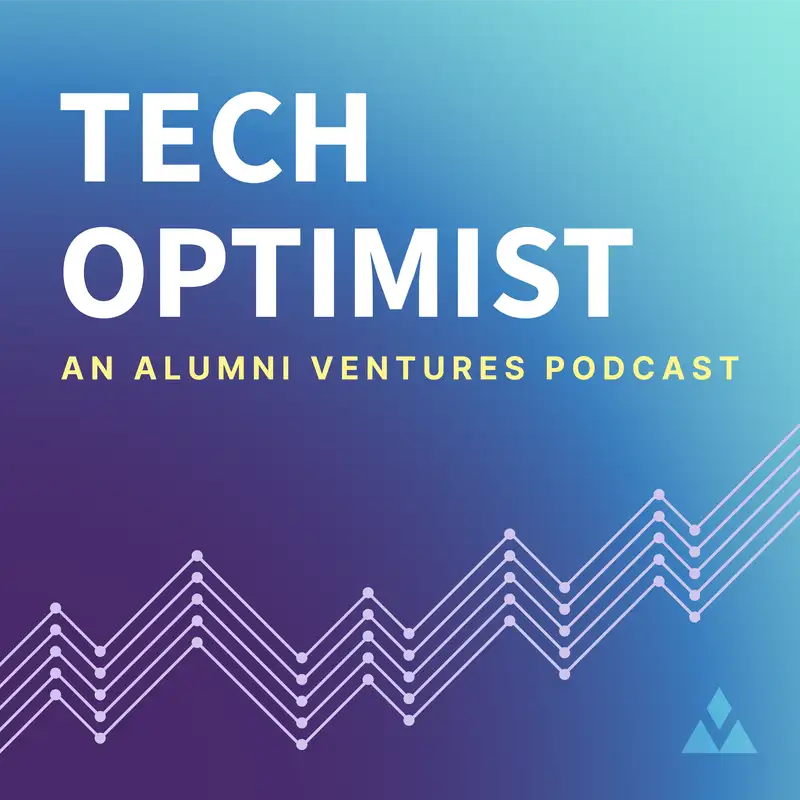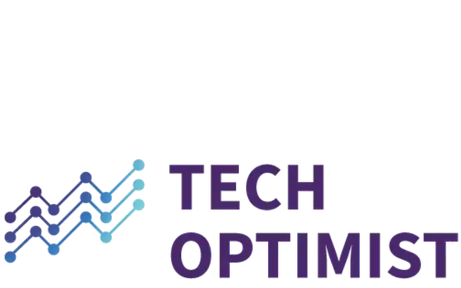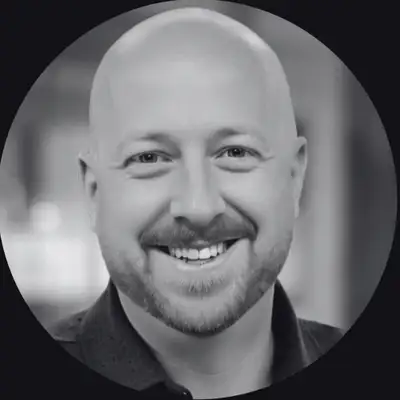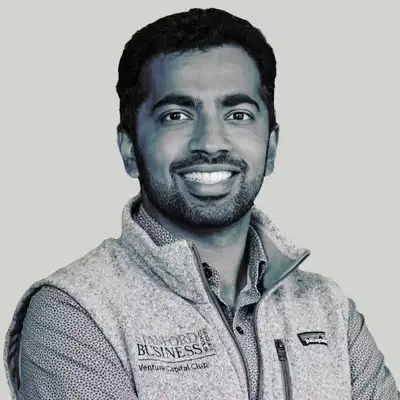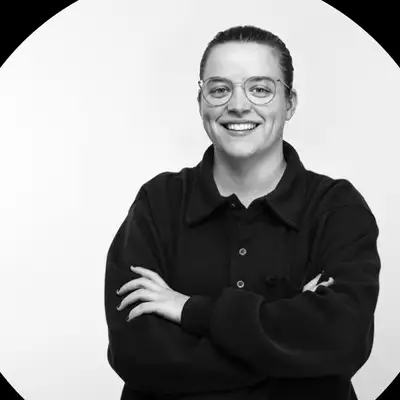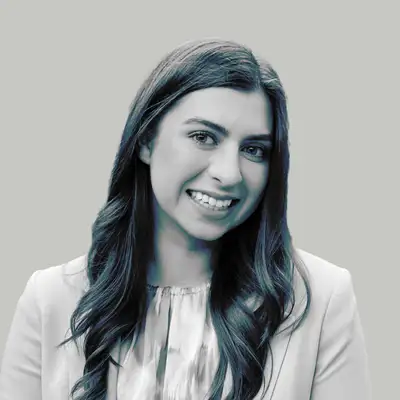#70 - Three Breakthroughs: More on AlphaFold
Sam Herrick:
Welcome to the Tech Optimist. This is a podcast brought to you by Alumni Ventures. This is a show where we sit down and chat about the people, companies, and innovators cultivating tomorrow.
Mike Collins:
If 2024 was the year of AI, I think 2025, 2026 could be the year of the robots.
Sam Herrick:
That is Mike Collins, co-founder and CEO of Alumni Ventures.
Naren Ramaswamy:
And suddenly, it's doing that much better and much quicker in a matter of minutes what scientists would've taken months or years to figure out.
Sam Herrick:
And on the other side of the table, Mike's partner for the next few weeks is Naren Ramaswamy, senior principal at Alumni Ventures. And that's me. My name is Sam Herrick and I am the tech note writer and editor for the show. So hello everyone. Welcome to this really awesome Three Breakthroughs episode, and happy Halloween actually because this episode is coming out on Halloween or a day or two after, around Halloween. So we here at Alumni Ventures all hope you had a wonderful holiday and had a bunch of candy. So this episode is pretty sweet. Get it? Candy Pun. Okay. Okay. Okay, I'm done. But this Three Breakthroughs episode, Naren and Mike really break down some really awesome stuff. And I know that I might be a little biased, but seriously, the stuff that they bring up today in their breakthroughs is... They're cool breakthroughs. I don't know how else to describe it.
Again, I liked kind of what we did last week where I didn't tell you what the breakthroughs were because I think it's fun to sort of get a snippet and to sort of be surprised about what the breakthroughs are. But I can give you some hints. So the first breakthrough has to do with the Nobel Prize. The second breakthrough has to do with Elon Musk. And the third breakthrough also has to do with Elon Musk. So I'm going to let the guys take it away. But seriously, please, please enjoy this episode. Before we hop into the interview, however, we're going to take a few seconds for a ad and a disclaimer. So sit back, relax, enjoy the rest of your commute or enjoy the rest of your workday or wherever you are listening to us and we'll be right back.
Announcer:
Do you have a venture capital portfolio of cutting edge startups? Without one, you could be missing out on enormous value creation and a more diversified personal portfolio. Alumni Ventures ranked a top-20 VC firm by CB Insights is the leading VC firm for individual investors. Believe in investing in innovation, visit av.vc/foundation to get started.
Sam Herrick:
As a reminder, the Tech Optimist podcast is for the informational purposes only. It's not personalized advice and it's not an offer to buy or sell securities. For additional important details, please see the text description accompanying this episode.
Mike Collins:
Hello and welcome to Tech Optimist. This week's Three Breakthroughs episode. Naren, how are you doing?
Naren Ramaswamy:
Doing great, Mike. How are you?
Mike Collins:
I'm excellent. So I think you're up first this week again, just every week is just kind of shake your head, cool new stuff taking place. A lot of exciting stuff to talk about. So we're here obviously to talk about things that are at the intersection of technology, entrepreneurship, venture capital, just things that we're excited about, we think are going to change the world. Obviously, we have a lens of investing as venture capitalists, but a lot of stuff to be super excited about. How are you going to kick it off today, Naren?
Naren Ramaswamy:
Well, I'll start off by saying that it was really hard to pick just three breakthroughs this week. It seems like there's a lot happening across robotics, biology, AI, semiconductors, et cetera. And so we have to punt a couple topics to next week, but I think I'll start with just the field of biology, AlphaFold and the recent Nobel Prizes that AI has seemed to sort of pervaded. And just to give the audience a little bit of background on AlphaFold, this is an AI algorithm that was developed by Google DeepMind, the research division of Google. And their work recently contributed. The research contributed to work that led to a Nobel Prize for understanding protein folding structures.
And what's really cool about this is that AlphaFold, the algorithm, it can accurately predict protein folding, which is a major breakthrough only because scientists had to basically laboriously do trial and error to find the way proteins actually fold and what their structure is. And just for a little bit of context, proteins are produced by a series of molecular beads from amino acids. We might've learned this in the high school biology, and these proteins, they fold into a mechanical shape and that is crucial for how they function.
Sam Herrick:
So let's dive into AlphaFold a little bit because they have had a very interesting history. So as we know, as Naren had told us, this is a research division out of Google, and recently, AlphaFold 3 has come out with a crazy breakthrough with AI and pattern matching. So first off, a bit about AlphaFold's history, they're an AI system developed by Google DeepMind to predict the three-dimensional structure of proteins. Naren gave a really awesome little conclusion and summary earlier about what it does, but I think providing some history can really put some emphasis on the breakthrough that they've made recently. So in AlphaFold 1 from 2018 to 2020, AlphaFold proved that neural networks can model the protein folding mechanism. They achieved this through a significant leap in protein structure prediction accuracy, and won the CASP13 competition in 2018, outperforming all of the other methods that were there.
And then let's jump to AlphaFold 2, from 2020 to 2022. They made a fundamental breakthrough in protein structure prediction. So they achieved near experimental accuracy for many proteins. They released predictions for nearly all cataloged proteins known to science, and it has been used by millions of researchers globally for discoveries in areas like malaria vaccines, cancer treatments, enzyme design, and it just goes on and on. The list goes on and on. So now what we've all been waiting for, AlphaFold 3 of this year of 2024. So AlphaFold expanded beyond proteins to predict structures and interactions of various biomolecules, including DNA, RNA and small molecules, achieving at least a 50% improvement in prediction protein interactions with other molecule types compared to existing methods. It doubled prediction accuracy for some important categories of interactions, and it surpassed physics-based tools for biomolecular structure prediction without needing structural input information.
Now I'm not really a scientist and I don't know all of what that means, but I know that it's all good, right? Many green flags for AlphaFold 3 here. So some key capabilities of AlphaFold 3. Let's just scratch the surface on this, right? So it can predict the structure and interactions of all life's molecules with unprecedented accuracy. I'm going to say that again. It can predict the structure and interactions of all life's molecules with unprecedented accuracy. It models large biomolecules, proteins, DNA and RNA, as well as small molecules, which are called like ligands. It can model chemical modifications to molecules that can control cellular functions and it achieves higher accuracy in predicting drug-like interactions including protein ligand and antibody target protein binding. This is insane. So these breakthroughs have significant implications on various fields, including drug discovery, understanding disease mechanisms, developing biorenewable materials, creating more resilient crops, and accelerating genomics research.
AlphaFold has been recognized with numerous awards, including the Breakthrough Prize in Life Sciences, and has been cited over 20,000 times in scientific literature. Do you know how insane that is? 20,000 times in scientific literature. It's impressive if... So my fiance is in the biological field and he sort of broke it down for me a little bit. That number 20,000 times in scientific literature is crazy. So it's like a great achievement for scientists to even produce one piece of literature in the space that they're working in. So the fact that there are 20,000 other scientists, biologists, innovators, engineers out there that have cited this work for Google and AlphaFold 3 is crazy. It's just absolutely crazy.
So well done to Google. And I think we need to sort of deep dive into this a little bit more. So we also found a YouTube channel called TheAIGRID, and they produce a video, which is Google's AlphaFold 3 Just Changed Everything: AlphaFold 3 Explained. So this video, if you want to see it, we'll provide a link in the show notes. It's about 13 minutes long. Obviously, we're not going to play the whole thing, but here are some really exciting snippets from it. And yeah, just enjoy, let's sort of get the whole accurate resemblance on this thing because it's pretty crazy. You're not going to want to miss this.
Speaker 5:
You have to think about it like this. In every cell of every living thing, plants, animals, even us, there are literally billions of these microscopic machines. And these machines are made up of proteins, DNA and other funky molecules. And the thing is that none of these pieces work alone. They're all kind of interacting, combining in millions of ways. And only by seeing that interaction can we actually understand how life works. And this is where AlphaFold 3 comes in. So how does this actually work? So given a list of input molecules, AlphaFold 3 generates their joint 3D structure revealing how they all fit together. It models large biomolecules such as proteins, DNA and RNA, as well as small molecules also known as ligands, a category encompassing many different drugs. And they can model chemical modifications to these molecules which control the healthy functioning of cells that when disrupted can lead to disease.
We also see that AlphaFold 3's capabilities come from its next generation architecture and the training that now covers all of life's molecules. At the core of the model is a module that learns the grammar of protein folding by studying evolutionary examples, and then uses that knowledge to predict the 3D structure of new amino acid sequences, much like how we can predict the meaning of a new sentence after learning the grammar of a language. And it's a deep learning architecture that underpinned AlphaFolds 2's incredible performance. And after processing the input, AlphaFold 3 assembles its predictions using a diffusion network akin to those found in AI image generators.
Now here's where we have one of the predictions. So in this example, what we do have here is the spike of a protein of a common cold virus. The spike protein is a part of the virus that helps it infect our cells. And the AI model actually accurately predicted how this spike protein interacts with antibodies, which are the immune system's defense proteins that attack the virus and neutralize it. And of course, simple sugars. In this prediction that you're currently seeing on screen, the spike protein is in blue. The antibodies which try to stop the virus are shown in a turquoise. So the simple sugars are also shown in yellow. And these predictions essentially closely match what scientists have observed in real life experiments, which are shown in gray.
AlphaFold 3 saves so much time by providing accurate predictions that would otherwise require lengthy and expensive laboratory equipment. And AlphaFold 3 can predict these structures in literally hours or days. So Google actually launched this tool that actually helps you do this stuff. So scientists can actually use this for free. There's no fancy subscription needed. And basically, with a few clicks, any biologist can use AlphaFold 3 to make models of proteins, DNA, RNA, and other important molecules. And this is pretty huge because the AlphaFold server lets scientists quickly come up with new ideas to test out in the lab. And this cuts out the time on wasting guesswork.
Naren Ramaswamy:
So what this breakthrough is actually enabled is helping us understand how proteins actually function. It says the science of the human body-
Mike Collins:
[inaudible 00:13:35] how we work as human beings, right, as machines or cells.
Naren Ramaswamy:
Exactly. It's critical.
Mike Collins:
If you really shrink everything up, how do things work, it is really, this is at the core of how things work. And if you're going to have a drug that solves a problem or how things go wrong, this is really the tinker toys that are involved.
Naren Ramaswamy:
Exactly.
Mike Collins:
So it's keeping us alive, it's making us sick. There are drugs that make us healthy. This is a huge piece roadmap in understanding it. And again, it was awarded the Nobel Prize. People get that it is a huge deal in life sciences.
Naren Ramaswamy:
Yeah. We're still in the very early innings of AI being applied to biology. And what's really inspiring about this work is that it proves that AI is so good at pattern matching. When you think about ChatGPT and text, you give ChatGPT just the corpus of text data from the internet and it can predict the next word really well. In this situation, scientists over years have been collecting characteristics and data about proteins in a database. AlphaFold came in and was like, "All right, let's ingest this data and try to predict how the next protein is going to fold." And suddenly, it's doing that much better and much quicker in a matter of minutes what scientists would've taken months or years to figure out. And suddenly, it's an order of magnitude faster and more efficient. And to your point, we can understand the human body in a way that just wasn't possible before. And that's the first step to developing therapies.
Mike Collins:
And again, I think that underlying point Naren, I just want to emphasize, which is the world moving from these deterministic plans and rules and software to one that is much more around pattern recognition. So the analogy that I think is easier for a lot of people to understand in this regard is self-driving cars. So if you have to write software that says, "If this, then that," the complexity of that system to drive a car is really, really, really tough. If on the other hand, you just upload into a neural network learning system, just tons of information, video, how the steering wheel moved, all of that stuff, you aren't writing rules, you are just creating a garden that allows the AI to learn, observe, create patterns, test things. And I think this is a fundamental change of the way things are happening and work is being done.
And here is another example of really making something, using new tools to make understanding of the human body, biochemistry, et cetera, much more of an engineering problem. So we can load all this stuff in, we know enough to know what we'd like to have happen, but now, we're creating kind of a model of a human being. So in the same way we've created a model of language, which is so good, it seems like a human talking back to you, that we're beginning, and we talked about it last week of creating models of the human brain, and now we're doing it of proteins that are going to really strengthen the understanding of how we work. And if we understand how things work like we did with a genome project, solving problems starts with understanding things.
And so these models are really, really profound. And so I think the applications, as you point out, are AlphaFold, there's, I believe a business unit of Google now that is doing drug discovery, not really talked about much. I know there's a bunch of startups of people that worked at AlphaFold doing this. So it's a really ripe area in health tech investing that I think is really, really exciting about making human disease, just the four horsemen, just putting a stake in the heart of all four of them kind of thing.
Naren Ramaswamy:
Absolutely.
Mike Collins:
It's what we all want in our lifetime.
Naren Ramaswamy:
And just the last thing to add, because this is so groundbreaking, obviously, we're seeing a lot of activity in this space. We invested in a company called Q Bio, Quantified Biology alongside Vinod Khosla at Khosla Ventures, and again, another pioneering company in the space that's trying... So far, the problem statement for that company is healthcare has been reactive with regard to technology being applied to it. How do we make it proactive? So you're able to actually take a full body MRI scan, understand the parameters, and then that can become the basis of the preventative healthcare system in the future. And now with these other algorithms, AlphaFold, you can have many different therapies that have previously not been discovered. So I think healthcare is definitely one of the areas that we're going to see a lot of improvements and optimizations on.
Mike Collins:
Yeah, this is one of the three for today, but I was just reading a paper too about a new application with little lesions in lungs being able to be identified at kind of the precancerous stage like we do now with colonoscopies, right? If you can get in there early, snip these things out right away, kind of precancerous things. And what I had heard and read, which is they've deployed some of these systems and they were expecting... And this is in the lung area, they were expecting something like 500 at this medical center that they were seeing.
And once they applied AI to all of it, there was the quadruple the number of lesions that they were able to identify. Now that creates a lot more work and a lot more things to be snipped out, but these are things that are eventually at a very high rate become cancerous. So it's like you're saving lives by getting AI and data earlier in the process, which again, points to where we want to be, which is get these things before they're cancerous. Nanobots, all of that kind of stuff is around the corner. So very exciting.
Sam Herrick:
Okay, we'll be right back to the Three Breakthroughs episode right after this. Don't go anywhere.
Announcer:
Exceptional value creation comes from solving hard things. Alumni Ventures Deep Tech Fund is a portfolio of 20 to 30 ventures run by exceptional teams who are tackling huge opportunities in AI, space, energy, transportation, cybersecurity, and more. These game-changing ventures have strong lead venture investors and practical approaches to creating shareholder value. If you are interested in investing in the future of deep tech, visit av.vc/deeptech to learn more.
Mike Collins:
So just flipping gears a little bit, I mean, what a week for Elon Musk, right? I mean, love him or hate him, the guy is N of one. And I'm going to focus on again, the continuing progress of robotics, and just the robotics of self-driving vehicles getting better and better. I think we're looking at robots now that are serving drinks, having conversations, solving problems. I think if 2024 was the year of AI, I think 2025, 2026 could be the year of the robots. Because I think we're going to start seeing some commercially viable robots coming into the homes. Early adopters obviously high price, but they're going to have a huge wow factor. They're going to solve real problems. I think they're going to be deployed in a lot of...
Amazon just had a big release in the robotics space on more the industrial side. But again, I think it was another great week for robotic innovation. The dexterity, the AI combination, we've talked a lot about when you can combine hardware and software, when you can combine the AI that is now available on the edge, where you can have visual recognition, you can have voice, and now the dexterity to solve real day-to-day problems, I think it's a form of agency that is increasingly getting traction, and I think we are right on the cusp of stuff where these are going to be deployed in the next 12 months.
Sam Herrick:
Okay, now, so Mike's breakthrough, he brought up sort of Elon Musk's robot, which is called Optimus, and recently, Optimus came out with their newest Gen 3 release of this robot. So I have a video for you, it's about 90 seconds long, and it's from Tesla themselves, and it's just a video of Optimus working, of Optimus walking around, of it doing tasks, of it putting itself to sleep essentially, and putting itself back on charge, working with people, and navigating throughout an industrial complex. So first off, before we get into the tech note, we are going to play that video. So here's that video titled Optimus Navigating Around Tesla by Tesla.
And now I'm going to provide you a little bit more information on Optimus and Gen 3. So Elon Musk has confirmed that the Gen 3 Optimus will be available by the end of 2024 or early 2025. It's described as the final version, which is significantly different from Gen 2 version if you've been following along. And the design, it's more sleek, I guess is the best way to put it. If you want to see the visual, you can watch this on our LinkedIn and YouTube page anytime you'd like to see the video or go see the video on Tesla's YouTube page yourself.
But it has improved mobility and speed compared to various versions. It has enhanced hand dexterity and manipulation skills. It can perform a wider range of tasks, including household chores, some advanced features, and has improved AI and responsiveness. And it can answer questions in real time. It's got better human interaction capabilities, autonomous navigation and obstacle avoidance, integration with IoT systems and remote software updates. Some applications that can be brought into your home where it can water plants, carry packages, open car trunks. It can be used in a factory for factory work. It can be used in service industry roles. The list goes on and on.
It's like Tesla and Elon Musk, they don't stop. The innovations that they come out with every week it feels like are crazy. So the thing that we're all looking for is pricing. So Elon Musk has mentioned a target price of around $20,000 per unit and plans for mass production are starting in 2025. So that's like kind of a car, a little bit less than a new car, but they have potential leasing and rental options being considered, I guess. But some technology in this robot that some of you might enjoy. It leverages technology from Tesla's electric vehicles, including their battery systems, motors, and the use of AI, of course. It supports Wi-Fi 6 and 5G for faster connectivity. It's got improved battery life allowing up to eight hours of continuous operation. And it's important to note that while these details are based on recent reports and statements from Tesla, some information may be speculative or subject to change as the product is still in development. But yeah, crazy breakthrough number two, let's see what's next.
Naren Ramaswamy:
And there's been some negative press about the humanoid robot Optimus that Tesla put out saying there's been remote controlled in the background, people are operating the robot from afar, all that. But the reality is that this is a prototype and it's a matter of months, maybe a couple years, that we're going to actually see these performing tasks around us in an industrial setting or household use cases. Elon had a section where when he was presenting this, he said, "This robot can be your teacher, it can be your kid's babysitter, it can walk your dog, it can run water your plants."
Mike Collins:
Please, walk my dog, right? Yeah.
Naren Ramaswamy:
Think about the applications that allow you to spend more time doing what you enjoy, the human-related connections that you can build from the time that administrative tasks take, just automating those. So our life is going to change once these are more ubiquitous, and this is just the tip of the iceberg.
Mike Collins:
And I'll point to the fact too is this is the journey that one goes through with prototypes, right? I think their first version of Optimus was a guy in a suit kind of thing, walking around, and the first rocket blew up on the launch pad, right? Kind of thing. So it's like entrepreneurs can get carried away and Elon has gotten carried away with timing in particular, but at the end of the day, the guy has delivered, and he's delivered just incredible innovation in space. He's in robotics. He clearly shook up the EV market with Tesla.
And again, I mean 30 years of life experience, do not bet against these one in a billion people, the Steve Jobs, Elon Musk. There are handfuls of people that drive us forward by just being incredibly talented, but also kind of incredibly audacious and thinking big and taking huge risks and betting the farm. And just again, an incredible week for him and accomplishments. Even though not everything is shipping today and not everything is going to work. Yeah, it's easy to sit in the sidelines and bitch and moan about like, "Well, this, this and the other thing," but he's in the arena doing stuff.
Naren Ramaswamy:
Yeah, that's a good segue to the third breakthrough, which you touched on about the Starship flight five being caught by chopsticks or what folks are calling chopsticks.
Mike Collins:
Crazy. Yeah.
Naren Ramaswamy:
It's the contraption. But the cool thing about this is that a skyscraper size rocket thrown into space, caught back. And Elon, over the last 10 years, has been working on making space or democratizing space as a frontier. And one of the key aspects of that is reusing components of rockets.
Mike Collins:
Yeah, because it's cost. Yep.
Naren Ramaswamy:
Yeah, that's a huge cost. And now, because they've demonstrated that they can do it once, they can do it again, and space exploration, suddenly the reusability piece has been unlocked and it's now going to allow... And Starship is huge, right? It can carry larger payloads, it can unlock Mars and moon missions. That's been one of the things that Elon has talked about in the future. And so in addition to this engineering feat, I'm thinking about all the applications that are going to emerge in the future, which is what... If you think about SpaceX as the infrastructure layer for the space economy, what applications in terms of payloads or other features can be built on top of that? And that's an opportunity for other new startups to come in. We've seen this play out in the world of software. Infrastructure software companies like OpenAI have created many other application level AI companies. So this is going to be another platform. So exciting time to be a venture investor in space tech.
Sam Herrick:
All right, I told you we had Elon Musk in here twice. Starship flight five being caught by chopsticks. This is just insane. My motto for this breakthrough is going to be say less and show more. So I found this really awesome YouTube video by CSI Starbase on YouTube, which is titled Starship Flight 5 - Cinematic Experience from October 13th, 2024. Now, it definitely is cinematic, and it kind of gives you goosebumps as you watch this because the editor did an awesome job timing this up with Tesla's internal sort of audio and their engineers going crazy with this massive achievement that they've all achieved together. The footage is awesome. Again, we're going to cut this up so you're not going to see the full or listen to the full 10 minutes. We're going to cut it out so you get the important pieces. But yeah, say less, show more. Here is Starship flight five, if you haven't seen it yet.
Speaker 6:
The command was sent to the tower. We are go for catch.
Mike Collins:
I think it's a big milestone. The barrier to space has been cost, like cost per kilogram to get stuff up there, because there are applications with communications that are fairly provable, near in, there's a bunch of sensor stuff for the planet, weather, obviously defense, there's a lot of material science potential, there's a lot of mining, natural resource potential. But what has been the truth is you have to build a railroad every time to get up there. Imagine if you had to rebuild the railroad every time you wanted to run a train from St. Louis to Seattle, right?
Naren Ramaswamy:
Yeah, great analogy.
Mike Collins:
So we're building the railroad and we need to drive down costs per kilogram to get stuff up there. One of the big ways one does that is reusability. And so just the scale of a big ass rocket that was able to go up, come back down and be caught, and again, we'll just put the video in there for somebody that has missed it, it is mind-boggling what a feat of engineering this thing is. Again, not inventing science or changing the rules of physics. Just a really, really, really hard engineering problem that they cracked and executed on. And again, just the possibility. Elon has already figured out how to get stuff in space at one-tenth the cost of other people. And now again, continuing to break through.
I will also say it is unleashing the venture economy. There are other startups with other approaches that we are going to see. We've got Blue Origin from Bezos, but there are other startups that have been funded that have different approaches, different niches. We just need more. Some of them are going to work, some of them are going to work for niche applications, but we just need to get more stuff up in space, more reliably, cheaper. And the day is coming. We're not there yet, where three young engineers in a garage can have a startup idea and don't need $100 million. We're not there yet. We are still building the internet. We are still building the infrastructure, but we're talking about a market with infinite upside and infinite legs and infinite possibilities. So again, I think space for people in their 20s and 30s is an area, as an investor, that you really need to be watching, you need to be investing in because it's still going to be around in 30 or 50 years.
Naren Ramaswamy:
Absolutely.
Mike Collins:
So you want to lean in.
Naren Ramaswamy:
Yeah. Today we talked about space, biotech and robotics, right? Typically, venture investing the last 20 years has been primarily around software, but here, we have three breakthroughs that are really opening up new markets in venture, and yeah, it's inspiring.
Mike Collins:
Yeah. And it's a week, right?
Naren Ramaswamy:
Yeah. That's one week.
Mike Collins:
Yeah, Naren, we'll do it again next week. We'll see what crazy stuff will happen, but-
Naren Ramaswamy:
Exactly.
Mike Collins:
... Me, you live in interesting times. Okay. Thank you Naren. Talk again.
Naren Ramaswamy:
Thanks Mike.
Mike Collins:
Yeah. Bye.
Naren Ramaswamy:
See you. Bye.
Sam Herrick:
Thanks again for tuning into the Tech Optimist. If you enjoyed this episode, we'd really appreciate it if you'd give us a rating on whichever podcast app you're using and remember to subscribe to keep up with each episode. The Tech Optimist welcomes any questions, comments, or segment suggestions. So please email us at info@techoptimist.vc with any of those, and be sure to visit our website at av.vc. As always, keep building.
